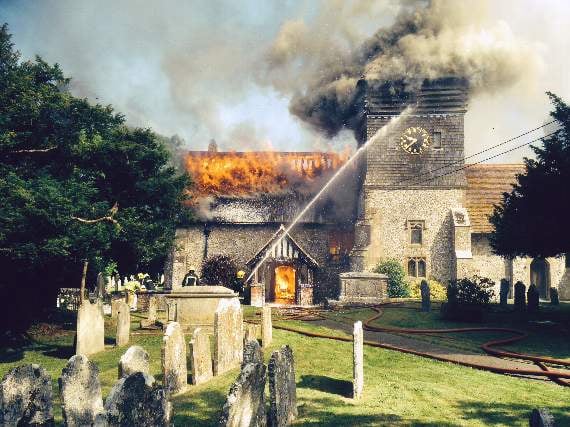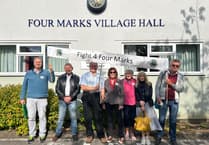THE village of Ropley rallied in true community spirit for the official launch of the St Peter’s Appeal Fund.
The £500,000 appeal is needed to support the rebuild of historic St Peter’s Church, devastated when fire ripped through the building in June 2014, leaving nothing but the burned out shell.
For centuries the focal point of the local community, the aim is to build a vibrant new church at the heart of the village, expected to cost in the region of £3m.
With this in mind, the parochial church council has been working alongside architect John Alexander, of Alexander Designs, and other agencies to draw up plans to create a church building that will not only reflect the past but provide all the facilities needed for future generations.
Permissions are now in place and the parochial church council is ready to move on to the rebuilding phase. The challenge now is to reach the fundraising target of £500,000 and since the launch the appeal has got off to a flying start.
According to church council spokesman Norma Day, over the two days around £20,000 was pledged by “some very generous people”, giving a solid boost to the initial fund of £45,000.
Held in the village hall, the launch event began on February 16 when the Bishop of Basingstoke, the Right Reverend David Williams, talked briefly about the tragedy of the fire four years ago before moving on to talk about the opportunity presented for the church and village community that the rebuild of St Peter’s presents. With the appointment of Clare Welham, as vicar for the benefice of Ropley, Bishop’s Sutton and West Tisted, and the new resource that the building will bring, Bishop David’s message was one of hope, planning and celebration.
According to Mrs Day, Bishop David also spoke highly of the dedication of the benefice church wardens and asked that the wider community come together to raise the funds required to make St Peter’s a church to fully fill current and future needs.
Architect Mr Alexander then took to the floor to give an overview of the proposed design and layout for the new church. He explained some of the challenges that had presented themselves during the recent opening-up works when a number of barrel tombs had been found under the altar area and some graves to the north of the church had been found to be as shallow as 40 centimetres.
He said that the grave nearest the surface was that of a small baby, near to the path. As a result, he had redesigned the floor so that it would lie above the baby’s grave and still go over the tombs inside the church.
Mr Alexander outlined the new facilities that would be built into the church – accessible toilets that can remain open even when the church is locked, a small kitchen area, a main church building with capacity for 200 people, a community room for 30 people, stores, lighting and heating using underfloor and air-circulation techniques. He concluded his presentation by running through a series of 3D renders of how the church will look.
Parochial church council member Andy Bonner continued with the presentation by explaining the finances of the project. Essentially, the parochial church council is in receipt of funds from the insurance company, including insurance cover, interest and grants which, together with money already raised and the possible sale of assets, could amount to £3,164,697, depending on the value of the sale of the Monkwood Mission Church.
Of this money, around £500,000 had already been spent in the clear-up of St Peter’s immediately after the fire, designs and working with the advisory agencies to get planning permission, and to cover the costs of the recent opening-up works.
Mr Bonner explained that the parochial church council was working with estimates supplied by a quantity surveyor to determine the cost but that, due to the nature of the project, which would include a substantial amount of repair and restoration, together with the fitting of a new building within the old one, there would continue to be an area of uncertainty as to the exact cost. The latest estimate for the rebuild was £2.7m, but there would be additional costs for the access road, bell restoration and internal fittings, leaving the parochial church council to raise between £350,000 and £500,000.
Mr Bonner went on to talk about how the parochial church council was planning to raise and monitor the £500,000 funding requirement. He explained the chosen system of pledge envelopes which will enable people to decide how much they wish to contribute, or think they may be able to raise, and take an envelope for that amount, returning it when they have raised what they can. Envelopes are available for all amounts from £1 to £1,000 to enable everyone to join in.
At the launch the parochial church council displayed an interactive version of the scheme on a TV monitor where people could select an envelope amount, which would then be taken from the screen to reveal a part of the new church.
Donation envelopes will also be available from the vicar, treasurer or church wardens, or from various locations around the village.
The Reverend Welham gave thanks not only to those who made donations but to those who had invested time, money and enthusiasm into making both the Friday evening and Saturday events a success and for getting the fundraising appeal under way.





Comments
This article has no comments yet. Be the first to leave a comment.